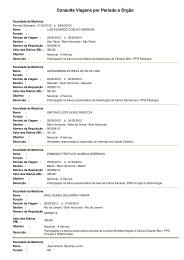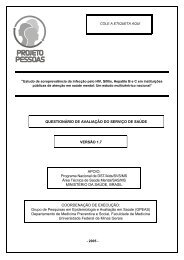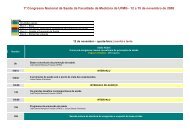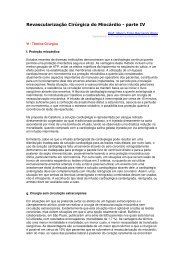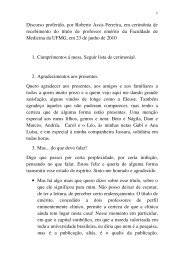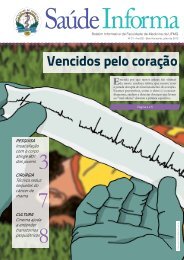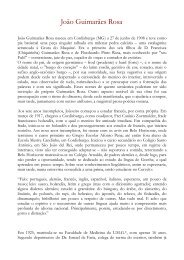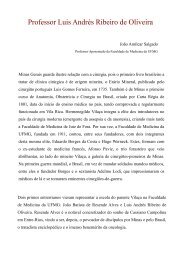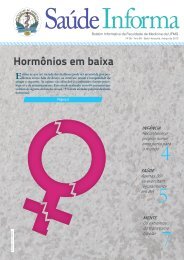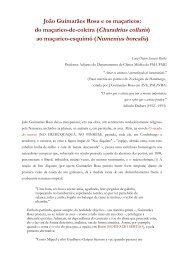Psiquiatria - Faculdade de Medicina - UFMG
Psiquiatria - Faculdade de Medicina - UFMG
Psiquiatria - Faculdade de Medicina - UFMG
Create successful ePaper yourself
Turn your PDF publications into a flip-book with our unique Google optimized e-Paper software.
A esquizofrenia <strong>de</strong> início tardio e a iniciada na segunda ou<br />
terceira décadas <strong>de</strong> vida se assemelham, sobretudo em relação ao<br />
curso crônico da doença. Por outro lado, alguns estudos apontam<br />
várias diferenças.5,7,8 A esquizofrenia <strong>de</strong> início tardio afeta principalmente<br />
mulheres com traços <strong>de</strong> personalida<strong>de</strong> pré-mórbida<br />
esquizói<strong>de</strong> ou paranói<strong>de</strong>, com déficits auditivo ou visual, características<br />
consi<strong>de</strong>radas fatores <strong>de</strong> risco para o <strong>de</strong>senvolvimento<br />
do transtorno. A prevalência <strong>de</strong> esquizofrenia nas famílias <strong>de</strong>sses<br />
pacientes é menor que naquelas <strong>de</strong> pacientes com esquizofrenia<br />
<strong>de</strong> início precoce. Os sintomas paranói<strong>de</strong>s, principalmente <strong>de</strong>lírio<br />
persecutório, prepon<strong>de</strong>ram na esquizofrenia <strong>de</strong> início tardio,<br />
sendo os sintomas negativos menos graves que na <strong>de</strong> início precoce.<br />
Ainda, pacientes com esquizofrenia tardia ten<strong>de</strong>m a respon<strong>de</strong>r<br />
a doses menores <strong>de</strong> antipsicóticos. O caso relatado contém aspectos<br />
característicos da esquizofrenia <strong>de</strong> início tardio: paciente<br />
do sexo feminino acometida em ida<strong>de</strong> avançada, com déficit auditivo<br />
e traços pré-mórbidos <strong>de</strong> personalida<strong>de</strong> esquizói<strong>de</strong>, apresentando<br />
quadro <strong>de</strong>lirante persecutório responsivo a baixa dose<br />
<strong>de</strong> antipsicótico.<br />
Essas diferenças levantam a questão se a “esquizofrenia <strong>de</strong><br />
início tardio” seria uma apresentação retardada da esquizofrenia<br />
ou uma entida<strong>de</strong> distinta <strong>de</strong>sta. Os atuais sistemas <strong>de</strong> classificação<br />
em psiquiatria CID-109 e DSM-IV10 não estabelecem limites<br />
etários para o diagnóstico da esquizofrenia, nem especificam a<br />
subcategoria “início tardio”.<br />
Não sendo a esquizofrenia <strong>de</strong> início tardio consi<strong>de</strong>rada entida<strong>de</strong><br />
distinta, quais os fatores protegeriam esses indivíduos até a<br />
manifestação da doença? Qual o motivo do maior comprometimento<br />
<strong>de</strong> mulheres? A resposta a essas e a outras questões <strong>de</strong>pen<strong>de</strong>m,<br />
em parte, da melhor compreensão da fisiopatologia da esquizofrenia,<br />
tornando bastante controverso o assunto.11<br />
Summary<br />
The authors present a case of psychosis in a 61-year-old woman without<br />
cognitive impairment. The patient was taken to a psychiatric<br />
hospital because of aggressive behavior against her neighbours. She<br />
was <strong>de</strong>fined by her caregivers as a shy and systematic person. She<br />
never had close relationships or boyfriends. Although her symptoms<br />
appeared at the age of 49 after her mother <strong>de</strong>ath, she had never<br />
been treated. After leaving her job, she started eating poorly and<br />
became isolated avoiding contacts with other people. Four years<br />
later, she <strong>de</strong>veloped evi<strong>de</strong>nt persecutory <strong>de</strong>lusions and auditory hallucinations.<br />
For 10 years she remained in this situation until she was<br />
taken to the hospital. During the hospitalization she was medicated<br />
with haloperidol 2.5 mg per day and her psychotic and aggressive<br />
behavior improved. The authors discuss the current classification of<br />
late onset psychosis.<br />
Key-words: Late-onset Schizophrenia, Late Paraphrenia, Late<br />
Psychosis<br />
Referências Bibliográficas<br />
1. Rossler AR, Rossler W, Forstl H et al. Late-onset schizophrenia<br />
and late paraphrenia. Schizophr Bull 1995; 21(3): 346-54.<br />
2. Christenson R, Blazer D. Epi<strong>de</strong>miology of persecutory i<strong>de</strong>ation<br />
in an el<strong>de</strong>rly population in the community. Am J<br />
Psychiatry 1984; 141:1088-91.<br />
3. Targum SD, Abbott JL. Psychoses in the el<strong>de</strong>rly: a spectrum<br />
of disor<strong>de</strong>rs. J Clin Psychiatry 1999; 60(suppl 8): 4-10.<br />
4. McClure FS, Glasjo JA, Jeste DV. Late onset psychosis: clinical,<br />
research, and ethical consi<strong>de</strong>rations. Am J Psychiatry<br />
1999; 156(6):935-40.<br />
5. Crespo-Facorro B, Piven MLS, Schultz SK. Psychosis in late<br />
life: how does it fit into current diagnostic criteria? Am J<br />
Psychiatry 1999; 156(4):624-9.<br />
6. Howard R, Rabins P. Late paraphrenia revisited. Br J<br />
Psychiatry 1997; 171: 406-8.<br />
7. Pearlson GD, Kreger L, Rabins PV. A chart review study of<br />
late-onset and early-onset schizophrenia. Am J Psychiatry<br />
1989; 146(12):1568-74.<br />
8. Jeste DV, Harris MJ, Krull A. Am J Psychiatry 1995;<br />
152(5):722-30.<br />
9. World Health Organization. The ICD-10 Classification of<br />
Mental and Behavioral Disor<strong>de</strong>rs. Geneve: World Health<br />
Organization, 1992.<br />
10. American Psychiatry Association. Diagnostic and Statistical<br />
Manual of Mental Disor<strong>de</strong>rs 4 ed. (DSM-IV). Washigton,<br />
DC: American Psychiatry Association, 1994.<br />
11. Davidson M, Powchik P. Commentary to “Late onset schizophrenia<br />
and late paraphrenia”. Schizophr Bull 1995;<br />
21(3):355-6.<br />
Casos Clin Psiquiat 1999; 1(1):21-23 23




